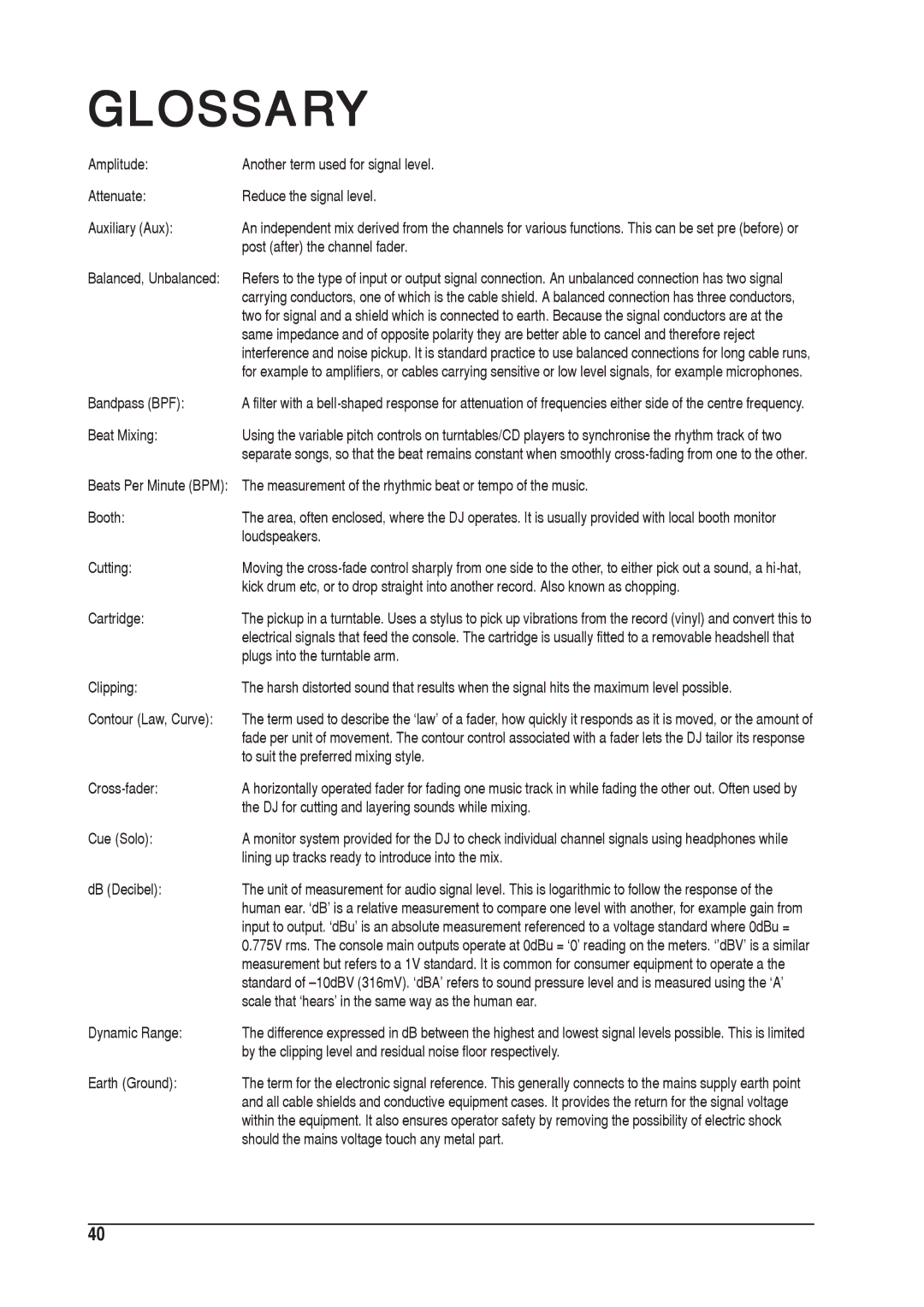GLOSSARY
Amplitude: | Another term used for signal level. |
Attenuate: | Reduce the signal level. |
Auxiliary (Aux): | An independent mix derived from the channels for various functions. This can be set pre (before) or |
| post (after) the channel fader. |
Balanced, Unbalanced: | Refers to the type of input or output signal connection. An unbalanced connection has two signal |
| carrying conductors, one of which is the cable shield. A balanced connection has three conductors, |
| two for signal and a shield which is connected to earth. Because the signal conductors are at the |
| same impedance and of opposite polarity they are better able to cancel and therefore reject |
| interference and noise pickup. It is standard practice to use balanced connections for long cable runs, |
| for example to amplifiers, or cables carrying sensitive or low level signals, for example microphones. |
Bandpass (BPF): | A filter with a |
Beat Mixing: | Using the variable pitch controls on turntables/CD players to synchronise the rhythm track of two |
| separate songs, so that the beat remains constant when smoothly |
Beats Per Minute (BPM): | The measurement of the rhythmic beat or tempo of the music. |
Booth: | The area, often enclosed, where the DJ operates. It is usually provided with local booth monitor |
| loudspeakers. |
Cutting: | Moving the |
| kick drum etc, or to drop straight into another record. Also known as chopping. |
Cartridge: | The pickup in a turntable. Uses a stylus to pick up vibrations from the record (vinyl) and convert this to |
| electrical signals that feed the console. The cartridge is usually fitted to a removable headshell that |
| plugs into the turntable arm. |
Clipping: | The harsh distorted sound that results when the signal hits the maximum level possible. |
Contour (Law, Curve): | The term used to describe the ‘law’ of a fader, how quickly it responds as it is moved, or the amount of |
| fade per unit of movement. The contour control associated with a fader lets the DJ tailor its response |
| to suit the preferred mixing style. |
| A horizontally operated fader for fading one music track in while fading the other out. Often used by |
| the DJ for cutting and layering sounds while mixing. |
Cue (Solo): | A monitor system provided for the DJ to check individual channel signals using headphones while |
| lining up tracks ready to introduce into the mix. |
dB (Decibel): | The unit of measurement for audio signal level. This is logarithmic to follow the response of the |
| human ear. ‘dB’ is a relative measurement to compare one level with another, for example gain from |
| input to output. ‘dBu’ is an absolute measurement referenced to a voltage standard where 0dBu = |
| 0.775V rms. The console main outputs operate at 0dBu = ‘0’ reading on the meters. ‘’dBV’ is a similar |
| measurement but refers to a 1V standard. It is common for consumer equipment to operate a the |
| standard of |
| scale that ‘hears’ in the same way as the human ear. |
Dynamic Range: | The difference expressed in dB between the highest and lowest signal levels possible. This is limited |
| by the clipping level and residual noise floor respectively. |
Earth (Ground): | The term for the electronic signal reference. This generally connects to the mains supply earth point |
| and all cable shields and conductive equipment cases. It provides the return for the signal voltage |
| within the equipment. It also ensures operator safety by removing the possibility of electric shock |
| should the mains voltage touch any metal part. |
40
